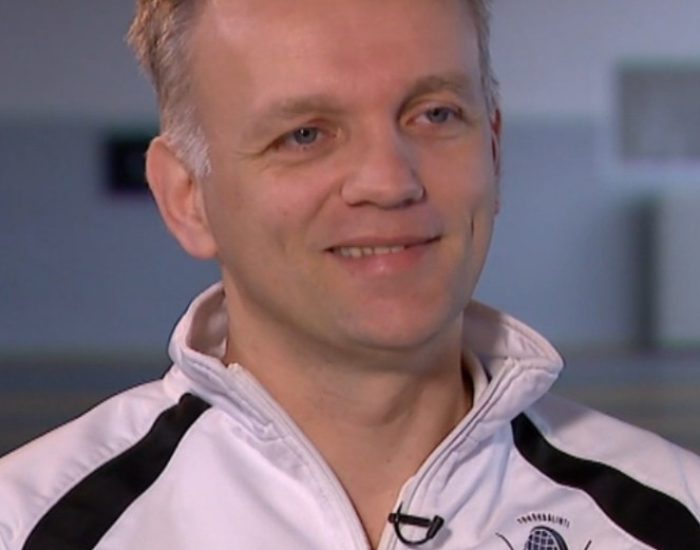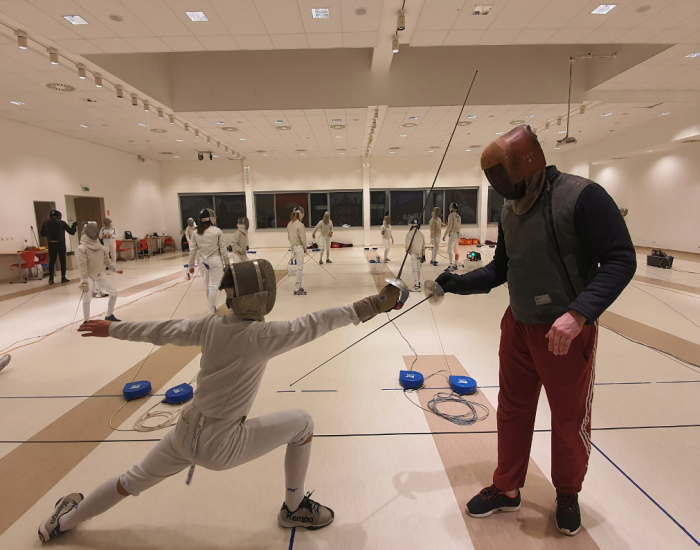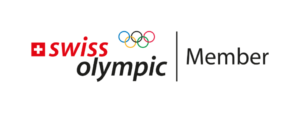

Säbelfechten
Zsolt Nemcsik
Zsolt, may I say that you are one of the best known and most successful sabre fencers Hungary has ever had? You have taken part in three Olympic Games, winning silver in the individual competition in Athens in 2004, and many more. Today you have your own fencing school, work for the University of Physical Education, for the Hungarian Fencing Federation, for the FIE and present major events such as the 2024 Olympic Games in Paris on Hungarian sports television. It’s fair to say that you’ve built a great career after your elite sports career. How big was the effort?
Zsolt: I would not say that I am the best known hungarian sabre fencer, however the bar is high here in Hungary… I have achieved a couple of awards, but here are a lot more powerful fencers still ongoing… The 3 times olympic champion, Aron Szilagyi is still active, planning to return after Paris olympics, Andras Szatmari, individual world champion is aiming Los Angeles from now, both the mens’ and womens’ sabre teams are defending champions at the World Championships. Here we are bound of traditions, and of course, I was a part of this, and now, after finished my sports career, I try my best to give back to our sport what I got from it, when I was young. This is my life, and I am lucky that I can work in the field, what I really love.
Back to the beginnings: When, where and why did you start sabre fencing?
I started fencing in my age of 9, I followed my elder brother. He was talented, and it was no question that I will follow him. Our luck was that we met one of the best coach, mentor, trainer, pedagogue, György Gerevich in Vasas Fencing Club Budapest. He was the elder son of the most successful hungarian athlete in th olympic history, the 7th times sabre olympic champion, Aladar Gerevich. He became coach in a very youth age, but he was the one who left the best heritage to hungarian sabre fencing, before his unfortune death in 2008. He taught fencing and raised a large number of champions, i.g. Aron Szilagyi, Andras Szatmari, Nicolas Iliasz, myself, and a lot more fencers, whom became at least hungarian national champions
In certain countries, such as Holland, the first weapon that children get their hands on is the sabre. What is it like in Hungary?
Technically it would have been better (and it was like that in Hungary until the 80’s), if children could start fencing with foil. That is the weapon of fine motoric skills. The small target, the light weapon and the precisement of the thrusts can give a perfect basic to a fencer, then after they can specialise according to their skills. Nowadays, we do not have enough time to master these skills, due to the youth competition system and the demand for results, which is not a good process, if we want to raise the whole talent of a young athlete. But it is, what it is, to answer the question, in Hungary, the first weapon, what the children can get is depending on the coach, who is there, in the given club. The weapon categories have been divided pretty much in the last couple of decades, now we can speak about 3 different sport, especially because their physical demand. The coaches are specialised in their weapon, and do not want to teach any other.
How do you rate the popularity of fencing in general in Hungary? And how popular is the sabre compared to the epee or foil?
Fencing is a layer sport in every country, because of its complexity. Very difficult to learn and, most importantly, very difficult to understand for average people. We can not compete with ball games in popularity and numbers. Here, in Hungary, we have traditional sports, which not that popular in other countries. This is because their past results. The Hungarian sabre was unbeatable from 1908 till 1964 at the olympics, that is coming to people’s mind: if sabre, then it is 2 golds at the olympics… But since then the sport has changed a lot, we lost that dominancy, but still there is some respect towards fencing in Hungary. (of course, it is just because we still have nice results). Inside fencing, we can say that, epée is the most popular (as everywhere on the world), 50% of fencers are doing this discipline, the other 25–25% is divided between foil and sabre.
As you may know, the sabre is not very common in Switzerland. Especially not in German-speaking Switzerland. You lived in Zurich for a while and know the mentality. Is it because of the temperament of the German-speaking Swiss, or what other reasons do you see?
It is always depend on the traditions. We have to go back in time to understand this. Fencing is a military sport, it was the primary tool of fight until the invention of powder but they still tought fencing on military academies until the 2nd World War…
The 3 disciplines of modern fencing are coming from different cultures. The epée and its practice weapon, the foil are coming from the medieval age western countries, from the territory of the current France, Germany, Spain and Italy. The sabre was the weapon of the eastern countries’ cavalry (mongols, turks, hungarians). They were using their curved, one edged blades from the back of the horse, and that is why a cut was much effective, than a thrust. In contrast, the epée was a deadly weapon of an armoured knight. And Switzerland, because its geografical position, is a part of the western culture, there was no demand for sabre.
Of course, when sport fencing was formed, around the turn of the 19th–20th Century, western countries were adopted sabre as well, but genetic predisposition can not be erased from the modern sport either.
“But talented children are everywhere, so I think, to make sabre more popular in Switzerland, it only depends on some common will, coming from the sport-leadership, open thinking and hiring good coaches whom are able to build something from zero, starting the club work with little children.”
Back to your career. How did you train back then to get to the top of the world? What did it take from you personally?
Fencing is an individual sport. In youth ages you need to learn technics and tactics, then how to compete and finally, in senior age, how to increase your performance. On the way, of course, you need partners (fencing alone is not possible:)). I learned that from my coach, the hard work always pays off, and fencing is a sport, what teaches you many things, what you can use in your private life too… You learn to be disciplined, determined, punctious, precise, to deal with stress, to solve problems individually, to manage your time, to develop cognitive skills, and a lot more, what is useful, even if you could not become world champion. And everything is possible without 6-8 hours of daily training, not like in cyclic sports, therefore you still have time to educate yourself in other fields…



I could imagine that an international training exchange is of great importance to get to the top. Did you already practice this during your active times? And how is this practiced in Hungary today?
International exchanges are always was an important part of professional fencing activities. It is important that we find the right fencers and 2 good spots in the calendar. Usually it depends on the contact between Federations, coaches and works on an exchange basis, one is hosting the other, then they change.
What is also decisive for the success of the athletes are the structures, the functioning system that is aimed at success. Can you tell us what the typical athlete pathway is in Hungary, how the athletes are developed and supported?
The children start to learn fencing, then they face the youth competition system, which is starting at the age of 10–12. After passing U13, U14, and U15 categories, they become a part of the first official international level category competition system, the U17 Cadet Circuit and the Zonal and World Championships. Of course, the last 2 is available only for the best 3–4 fencers of each country. This is the first step to learn how to compete on international level. Then there is the U20 Junior category, which is the anteroom of the senior competitions.
“We really need to take a look into the performance-management of senior category fencers. The development of athletes mostly depend on their coach, the club conditions and other professionals, like psychologists, conditional coaches, dietetics, physiotherapists, etc.”
The Hungarian Federation has a strong support by the State, therefore it is able to assist young athletes with a scholarship, which is based on their international results. Of course, it is valid for senior athletes too and the Federation provide the professionals above for our best fencers.
There are evil tongues that claim that extraordinary successes cannot be celebrated without high pressure to perform. Would you agree?
It’s a simple training theory. I increase the load (pressure), they get tired, then take a proper rest, then load again, rest, etc., and this is how the adaptation takes place. So the “pressure” (and the resting time too!) must be fair enough to get a result to be celebrated…
“If I would joke, I would quote a Hungarian saying: ‘Who do not know how to rest, those do not know how to work hard either…’”
Hungarian athletes are not only very successful in sabre fencing at the moment. What is Hungary doing better than other countries? And where do you think is still potential for improvement?
Actually, epée is more successful in Hungary right now, the mens team won olympic gold in Paris. They have a talented, young team and a professional background, including the modernest methods. We always have to look forward, stay with opened eyes and when we see something useful, we have to grab it to increase the performance. And we need to keep up the technical superiority, which was always the greatest advantage of the Hungarian fencers.
The famous white sheet: how would you make sabre fencing great in a country where nobody knows sabre fencing yet? What measures should be taken in the short, medium and long term? Which partners are decisive?
In my opinion, it is not possible without some central will, local clubs need to be convinced (and maybe supported financially) to hire coaches whom are able to grow up groups of children from zero.
“It would take 10–15 years to reach international level in youth categories, if everything worked well. Of course it must happen in as many clubs as possible in the same time. It is a looong-long way, needs a lot of determination and sacrifice.”
Beside this, the Federation can start to organize tournaments with invitation of foreign fencers to show to the children (and to everyone) where the sabre fencing can reach out. It helps to increase the popularity. Also possible to organize Team Championships with big names, that is always very exciting and spectacular. These ideas cost a lot, but I do not see other options.
And last but not least: Zsolt, what are your visions, where do you see the Hungarian Sabre in the future?
This is a very good question. The ladies will be around the top until years, we have a young and strong team. The men will be an interesting story, the older big guns are now starting to return after Paris, but there is a huge gap behind them. This hole must be patched, and the inheritors of Áron Szilágyi must be found in the next 4 or rather 8 years. It is a noble and honorable task, but it will not be easy to deliver.
Zsolt Nemcsik is an established Senior Lecturer in the Department of Combat Sports, specialising in sport fencing education. A successful Hungarian sabre fencer himself, he has extensive coaching experience, among others, having served as Head Coach of the Hungarian Men’s Sabre National Team and the FIE Sabre Coaching Academy. Nemcsik emphasises the importance of international coaching in sport fencing at both bachelor and master level.
His academic background includes a degree in Light Industrial Engineering and a Masters in Sports Coaching. His notable achievements include an Olympic silver medal in individual sabre fencing (Athens 2004), multiple World Team Championship titles (1998, 2007) and received the Knight’s Cross of the Order of Merit of the Republic of Hungary in 2004.
Zsolt Nemcsik is actively involved in both teaching and research, covering topics such as fencing methodology, fencing history, and strategy and tactics in sport fencing. His current research interests include the movement dynamics of sabre fencing and the integration of artificial intelligence into the sport.
He also has a media consultancy role, as a commentator for M4Sport Television, and international coaching experience, including positions in Hungary, Italy and Switzerland. His leadership in fencing education and achievements make him a prominent figure in the sport of fencing.







